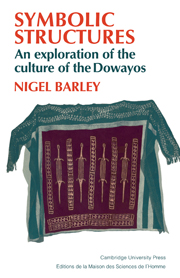Book contents
- Frontmatter
- Contents
- Acknowledgments
- Preface
- 1 The ethnographic background
- 2 Symbolism and the punctuation of culture
- 3 Some problems of the representational model of symbolism
- 4 The leopard cannot change his spots
- 5 Water and fertility
- 6 Tarniisnohgbarklele: ‘the place where the old Fulani woman was beaten to death’
- 7 ‘It is only thanks to me that you were circumcised’
- 8 The seasons of the year and the joker in the pack: relations of nesting and quotation
- Appendix: The festivals
- Notes
- Bibliography
- Index
3 - Some problems of the representational model of symbolism
Published online by Cambridge University Press: 07 May 2010
- Frontmatter
- Contents
- Acknowledgments
- Preface
- 1 The ethnographic background
- 2 Symbolism and the punctuation of culture
- 3 Some problems of the representational model of symbolism
- 4 The leopard cannot change his spots
- 5 Water and fertility
- 6 Tarniisnohgbarklele: ‘the place where the old Fulani woman was beaten to death’
- 7 ‘It is only thanks to me that you were circumcised’
- 8 The seasons of the year and the joker in the pack: relations of nesting and quotation
- Appendix: The festivals
- Notes
- Bibliography
- Index
Summary
In chapter 2, I looked at some aspects of symbolism as a punctuation of culture into domains, as a system of similar patterns. I should like to move on to a consideration of representational symbolism, which is what the man in the street tends to mean by symbolic analysis. Most of anthropology's standard approaches to symbolism are based upon linguistic models. The representational model relies – often unconsciously – on a naive notion of word meaning. A typical exponent of the genre is Victor Turner. For Turner (1967: 19) ritual is composed of symbols. Symbols are things ‘regarded by general consent as naturally typifying or representing or recalling something by possession of analogous qualities or by association in fact or thought’.
In other words, symbols are meaningful and motivated. The word ‘motivation’ recalls Saussure, the source of most semiological theory. In treating language, Saussure (1974: 69) begins by excluding onomatopoeia, the linkage of sound and sense. He is operating entirely within language as a system of arbitrary signs. But, while he insists strongly on the arbitrary nature of the linguistic sign (1974: 67), he has a great deal to say about motivation. He allows that words may be relatively motivated (1974: 131) i.e. that although Fr. dix and sept are arbitrary, their product dix-sept is not.
- Type
- Chapter
- Information
- Symbolic StructuresAn Exploration of the Culture of the Dowayos, pp. 21 - 38Publisher: Cambridge University PressPrint publication year: 1983

